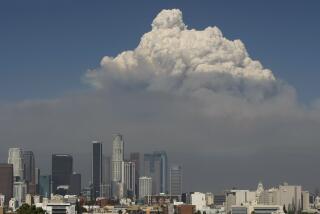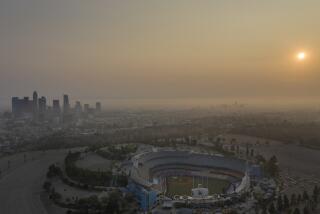Breathing Gear for Brush Fire Crews Sought
Chief John Sharry was tired of watching his firefighters who protect the vast test range at Lawrence Livermore National Laboratory return from brush fires coughing and wheezing.
So he outfitted his 32-member crew with the same type of air-purifying masks that industrial workers have used for years.
Sharry’s fire force at Lawrence Livermore east of San Francisco and one county department in Florida are reportedly the only agencies in the nation that provide lung protection for crews battling forest and brush burns.
Nearly all the nation’s 80,000 wild-land firefighters carry only cloth bandannas, stashing them in their helmets and pulling them out when they encounter heavy smoke.
Finding respiratory gear that is safe and equipping thousands of firefighters is a task that could take years of study, fire officials said.
The respirators worn by urban firefighters battling structural fires weigh about 40 pounds, and the air supply lasts only up to half an hour. Wild-land firefighters, however, already carry up to 60 pounds of equipment and they often spend up to 36 straight hours inhaling dense smoke on a fire line.
“The key is to see what can be done to mitigate the health risk and still allow us to fight fires. We’ve got to put these people on the fire line for hours and hours and days and days,” said Bill Teie, chief deputy for fire protection at the California Department of Forestry.
Air purifiers, which weigh 1 pound and include full face masks and filtering cartridges, remove nearly all the tiny particles of soot that pass through bandannas and embed in lungs, Johnson said. The Lawrence Livermore firefighters, who have worn them for five years, suffer less lung irritation and don’t cough up black mucus after fires, he said.
But the devices filter out only particles--not the carbon monoxide, acids, aldehydes and other toxic gases that health officials suspect are the main dangers in smoke.
Fire officials said they would rather wait until more effective equipment is found, although they say it could take years.
“It’s only good for about half the substances, and 50% isn’t good enough,” said Jack Wiest, chief of fire planning and research at the California forestry agency. “If anything, it would only give firefighters a false sense of security.”
Rich Duffy, health and safety director for the International Assn. of Firefighters, which represents 185,000 firefighters, said the union is pushing for respiratory protection but finding the right type is “quite a dilemma.”
“Equipment that fools firefighters into thinking they are fully protected could put them in environments that are even more trouble,” he said.
But Johnson said partial protection is better than none. He believes that some of the wariness by fire agencies is the cost of protection. Each purifier, which can be purchased in industrial equipment stores, costs about $100.
“The weight, the maintenance, the training, the cost are all factors that have to be considered,” said Michael Catlin, health and safety officer for the state forestry department.
Firefighters in Brevard County, Fla., an area vulnerable to brush fires, were tired of waiting for management to provide protection, so some spent their own money buying the purifiers. Six months ago, the county department provided them for all 160 firefighters.
By this fall, the Lawrence Livermore firefighters will start wearing a “smart” version equipped with sensors that alert them when carbon monoxide levels are dangerously high.
“It’s not that the technology isn’t out there,” Wiest said. “It’s just that nobody has been looking for it.”
HOW POISONS IN SMOKE AFFECT FIREFIGHTERS Wild-land firefighters are exposed to a variety of poisonous substances in the smoke they breathe. When forest material or brush catches fire, the incomplete combustion turns the harmless vegetation into a barrage of dangerous chemicals. The Poisons: 1. Carbon Monoxide--This invisible odorless gas attacks the brain and nervous system of a firefighter, causing temporary disorientation, impaired judgment and slower reaction times. It also puts extreme stress on the heart. 2. Inorganic Compounds--Including lead and sulphur, these materials vary widely in smoke, depending on the content of the soil. Lead, found in high concentrations in smoke from Southern California wildland fires, can cause neurological damage. 3. Aldehydes--These strong irritants, especially acrolein and formaldehyde, are found in high concentrations in smoke. They are believed to cause much of the wheezing, coughing and eye irritation suffered by wild-land firefighters. Many of them are also carcinogens. 4. Particulates--These small pieces of black carbon lodge deep in the lungs, possibly causing asthma, chronic bronchitis and cancer. The smallest particles, which are the most dangerous to lungs, are found in smoldering fires, where firefighters spend most of their time. 5. Ozone--This potent chemical is formed during fires when there is strong sunlight and smoke is trapped by stagnant weather patterns. Human tests show ozone, which is also the main ingredient of smog, hampers lung function, while animal tests indicate it can cause chronic respiratory disease. 6. Organic Acids--Including formic acid and acetic acid, these chemicals are powerful irritants to the lungs, eyes and throat. The Protection: Bandanna: Wild-land firefighters wear nothing but a thin cloth on their face to protect their lungs from smoke. Fire officials say they haven’t found lightweight respiratory equipment that is effective and safe for the crews, who have to trek uphill wearing 60 pounds of equipment. Equipment: Standard gear usually includes a hosepack, helmet, goggles, boots and a fire-retardant jumpsuit. Air Purifier: Fire crews at Lawrence Livermore National Laboratory wear 1-pound air purifiers. The smoky air passes through filters that eliminate tiny soot particles that can lodge in lungs. Gases such as carbon monoxide, however, are not filtered out. National and state fire officials remain wary of the purifiers because they don’t provide full protection from smoke.
Polynuclear Aromatic Hydrocarbons: These Compounds, believed to be cancer-causing agents, attach to particles of soot in wild-land fires. Experts are uncertain whether the compounds cause genetic damage in blood cells.
Sources: USDA Forest Service Intermountain Research Station, California Department of Health Services and Johns Hopkins University School of Hygiene and Public Health, Lawrence Livermore National Laboratory
More to Read
Sign up for Essential California
The most important California stories and recommendations in your inbox every morning.
You may occasionally receive promotional content from the Los Angeles Times.










